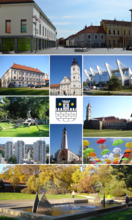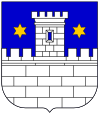Čakovec
| Čakovec | |||
|
|||
|
|
|||
| Basic data | |||
|---|---|---|---|
| State : |
|
||
| County : |
|
||
| Height : | 164 m. i. J. | ||
| Residents : | 27,104 (2011) | ||
| Telephone code : | (+385) 040 | ||
| Postal code : | 40,000 | ||
| License plate : | ČK | ||
| Structure and administration (status: 2013, cf. ) |
|||
| Community type : | city | ||
| Mayor : | Stjepan Kovač ( SDP ) | ||
| Coalition partner : | HNS, HSS, HSU, MDS | ||
| Postal address : | Kralja Tomislava 15 40000 Čakovec |
||
| Website : | |||
 |
|||
Čakovec [ ˈtʃǎkɔʋɛts ] ( German Csakathurn or Tschakathurn , Hungarian Csáktornya ) is a town in northern Croatia and is 164 m above sea level. d. M. It is the largest city in the Međimurje region . This is the area between the Mur and Drava rivers, Drava in Croatian, which is known for its vineyards, agriculture and numerous hunting grounds.
In the immediate vicinity is Varaždin , the capital of the Hrvatsko Zagorje , another important Croatian region (only 14 km southwest of Čakovec). Čakovec is the administrative seat of the Međimurje County . According to the 2011 referendum, the city and the suburbs have 27,104 inhabitants, the city itself has 15,147 inhabitants. The largest ethnic group are Croatians (Roman Cath.). The largest national minorities are the Roma , Serbs and Slovenes .
traffic
The first railway line was completed in 1860. It connected Budapest with the ports in Rijeka and Trieste . Čakovec is connected by a railway line with the places Mursko Središće and Lendava ( Slovenia ) (1889). The road infrastructure is good. This also includes the A4 motorway , which connects the Hungarian-Croatian border crossing Goričan with the capital Zagreb , Karlovac and the Adriatic Sea .
history

According to Strabo , who reported in the 1st century AD, at the time of the old Roman Empire, the area of today's Čakovec was the settlement of Aquama (wet town), a military outpost and legionary camp.
The name of the city comes from Count Demeter Csáky , who had a low castle built at the beginning of the 13th century , which was later also called Csáky's Tower (Croat. Čakov toranj) . It was first mentioned in 1328. The town has been found in official documents since 1333.

A more significant economic and cultural prosperity of the town of Čakovec began in 1547, when Nikola Šubić Zrinski (ung. Miklos Zrínyi) from Siget became the owner of this area. At that time, the Zrinski Castle was richly decorated and surrounded by a park with sculptures of well-known generals and rulers. The general Juraj IV. Zrinski granted privileges to the residents of the Čakovec fortress and the surrounding settlements on May 29, 1579 , which marked the beginning of the transformation of the town of Čakovec into a free trading town. This date is also the time of the annual city festival.
By the 18th century, a settlement made of wooden buildings developed next to the fortress, which is now in the center of Čakovec. In 1738 the city was destroyed by an earthquake . A major fire followed in 1741. Another earthquake struck the town in 1880. At the end of the 18th century, the Feštetić counts (Hungarian Festetics) became the owners of the town, which was transformed into a large estate in which industry , trade and commerce developed. In 1848 Banus Josip Jelačić liberated Čakovec from the Hungarians and joined them to Croatia. Electric power was first introduced into the city in 1893. From 1941 to 1945 the city was under Hungarian occupation. In 1945 it was liberated by the Soviet Red Army .
today
Čakovec is the economic, transport, cultural and administrative center of the Međimurje County. In Čakovec there is a grammar school, a technical middle school, a middle school for construction and a higher school for teacher training.
The region's economy is based on the textile industry ( Čateks , Međimurska Trikotaža ), the shoe industry ( Jelen ), food production ( Vajda , Čakovečki mlinovi ) and metalworking companies. The Zrinski company's editorial activity is also important .
Even if Čakovec is a city of modern architecture, a dynamic city with a highly developed industry and a center of communication, manufacturing, trade and education within and between the counties, its old core is well preserved and renewed. The local museum of Međimurje inside the fortress is a repository of 17,000 valuable exhibits. Čakovec also has a library, a theater, a hospital, numerous commercial centers that have been built in recent years and a sports and recreation center, which includes the stadium, the swimming pool opened in 1999 and a sports hall renovated in 2003. In the same year, this hall served as one of the venues for the women's handball world championship.
Especially in summer, Čakovec is the venue for numerous cultural events. In the first days of August there is traditionally a market in the city center. Since 2002, an annual automobile fair has been held regularly in May on the grounds of the municipal sports and recreation center.
Famous residents of Čakovec
- Lidija Bajuk (born 1965) - musician
- Lujo Bezeredi - sculptor
- Srećko Bogdan (* 1957) - football player and coach
- Milan Branović - tennis player
- Dragutin Feletar - historian, geographer and writer
- Joža Horvat - adventurer and writer
- Robert Jarni (born 1968) - football player
- Ladislav Kralj-Međimurec - artist, watercolorist
- Rudolf Kristofics-Binder (1896–1969) - businessman and politician
- Dražen Ladić (born 1963) - football player
- Ivan Novak - historian and politician
- Evelin Novak (* 1985) - opera singer
- Nikola Pavić - poet
- Fortunat Pintarić - musician
- Ruža Pospiš-Baldani (born 1942) - opera singer
- Franjo Punčec - tennis player
- Josip Štimec senior - world chess champion and winemaker
- Josip Štolcer-Slavenski (1896–1955) - composer
- Miljenko Turk - opera singer
- Filip Ude (* 1986) - Turner
- Drago Vabec - football player
- Juraj IV. Zrinski (1549–1603) - soldier, politician and patron
- Juraj (V.) Zrinski (1599–1626) - soldier and politician
- Nikola Šubić Zrinski (1508 or 1518–1566) - soldier and politician
- Nikola Zrinski (1620–1664) - soldier, politician, poet and philosopher
- Petar Zrinski (1621–1671) - soldier, politician and poet
- Vinko Žganec - folklorist
- Ivana Žnidarić - Miss Croatia 2006
Twin cities
- Nagykanizsa , ( Hungary )
- Schramberg , ( Germany )







